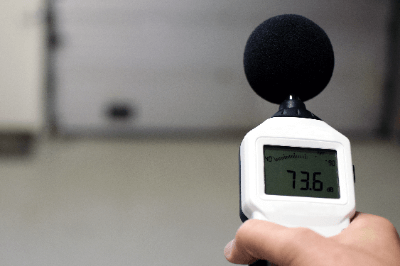What Are Sound Level Meters?
 Sound level meters are devices that measure environmental noise, and noise emitted by machinery.
Sound level meters are devices that measure environmental noise, and noise emitted by machinery.
In measuring noise level, it is necessary to consider how people hear the sound, rather than simply measuring the volume. Therefore, the ‘noise level’ calculated by weighting the sound pressure of loud or unpleasant sound is used to measure the degree of noise.
There are two types of sound level meters, the ordinary sound level meters and the precision sound level meters, depending on the accuracy of noise measurement.
Uses of Sound Level Meters
Sound level meters are mainly used in industrial applications.
They are used to measure machine noise at construction sites and factories. The permissible limit of noise is set by law, and it is necessary to confirm that the noise standard is met during construction work or when new machinery is introduced.
In addition, when constructing a house, the noise level inside the house must be kept below the standard value. Therefore, sound level meters are used to measure the noise emitted from surrounding roads and trains before construction.
Principle of Sound Level Meters
Sound level meters consist of a microphone, amplifying amplifier, frequency weighting unit, noise level calculation unit, and display unit.
The principle of sound level meters can be divided into the following three steps:
1. Sound Acquisition at the Measurement Location
The role of the microphone is to pick up the surrounding sound and convert it into an electrical signal. The microphone uses a diaphragm to measure the frequency by the vibration period of the diaphragm and the sound pressure by the vibration width. The electrical signal generated by the microphone is then amplified by an amplifying amplifier.
Sound level meters are classified into two types according to the measurement accuracy of the microphone: Sound level meters and precision sound level meters.
2. Frequency Weighting
The frequency of the electrical signal amplified by the frequency weighting section is weighted according to the frequencies that are easy for people to hear.
3. Noise Level Calculation
The role of the noise level calculation section is to calculate the noise level using the weighted frequencies and sound pressure. The calculation is performed using the equal loudness curve.
How to Select Sound Level Meters
A wide variety of sound level meters are available in a wide price range from several thousand yen to several hundred thousand yen. When using a sound level meter, it is necessary to select one according to the application.
1. Selection of Precision Sound Level Meters
Sound level meters are selected when highly reliable data is required, such as in university research or in the evaluation and development of acoustic equipment.
2. Selection of Sound Level Meters
Sound level meters are suitable for measuring the environmental noise of factories and residences, although they are not required to be accurate enough to be submitted to public organizations.
3. Selection of Simplified Sound Level Meters
Sound level meters are the best choice if you want to check the noise level as a rough guide.
Although it is inferior to the former in terms of performance such as accuracy and frequency band, it can be purchased at a price starting from several thousand yen, and anyone can easily measure the noise level.
4. Selection of Frequency Response
When selecting sound level meters , it is necessary to consider the frequency response. There are two types of frequency response, “A-response” and “C-response.
The “A-weighted” frequency response is a weighting of frequencies according to the human auditory sensitivity. It is suitable for measuring daily life noise. Basically, all products are based on the A-weighted frequency response.
The “C characteristic” is easy to detect in any frequency band. If you want to measure motor driving noise accurately, you should select the product with C characteristic, which are less affected by frequency response.
Other Information on Sound Level Meters
How to Use Sound Level Meters
The most important thing to keep in mind when using sound level meters is the effect of reflected sound. Sound level meters should be placed as far away from walls and other objects as possible when measuring sound, because sound reflects when it strikes an object. Ideally, the distance should be at least 3.5m.
Sound level meters should be mounted on a tripod or something similar, with the microphone facing the sound source. If the sound level meters are held by the person taking the measurement, he/she should keep the sound level meters as far away from his/her body as possible to avoid picking up the reflected sound from the body.